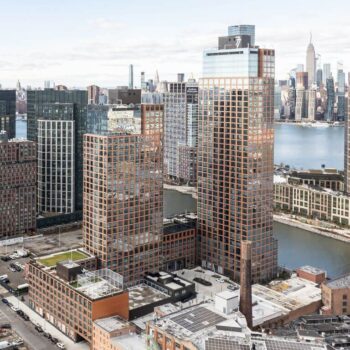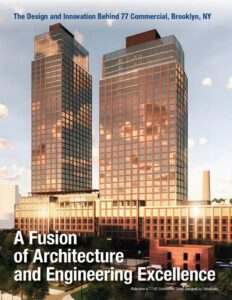 77 Commercial is one of the latest impressive new developments illuminating the Brooklyn waterfront. Located in Greenpoint between a beautiful landscaped inner court to the east and the Box Street Park to the west, 77 Commercial brings high-end living to a vibrant and rapidly developing neighborhood. The modern and innovative architecture fits seamlessly into the traditional architecture of the area while portraying luxury & beauty, with an abundance of natural light that enhances the public spaces around it. And with its sustainable and energy efficient design and innovative HVAC solutions, 77 Commercial fulfills the requirements of new climate regulation and compliance with Local Law 97.
77 Commercial is one of the latest impressive new developments illuminating the Brooklyn waterfront. Located in Greenpoint between a beautiful landscaped inner court to the east and the Box Street Park to the west, 77 Commercial brings high-end living to a vibrant and rapidly developing neighborhood. The modern and innovative architecture fits seamlessly into the traditional architecture of the area while portraying luxury & beauty, with an abundance of natural light that enhances the public spaces around it. And with its sustainable and energy efficient design and innovative HVAC solutions, 77 Commercial fulfills the requirements of new climate regulation and compliance with Local Law 97.
A Bold Pivot from $750,000 Annual Fines
In fact, Local Law 97 (LL97) was enacted to reduce greenhouse gas emissions and help New York combat climate change by setting specific emissions limits for buildings in April 2019. The 77 Commercial project was designed for gas PTACs, risking significant fines under the new regulations. The design team faced an important decision: Electrification of the building was necessary to comply.
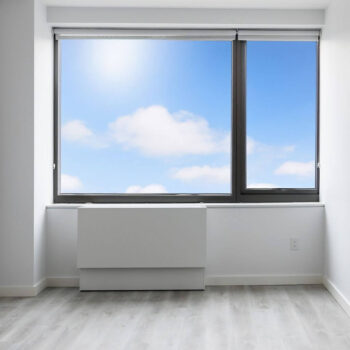 “Originally, we designed around gas PTACs, but when the LL97 directive came out, our analysis showed that continuing down that road would result in $750,000 in fines,” says Anthony Hannigan, PE, partner at GEA Consulting Engineers who was responsible for the engineering at 77 Commercial. “We knew a change was needed, and so we switched to an electric-based system.”
“Originally, we designed around gas PTACs, but when the LL97 directive came out, our analysis showed that continuing down that road would result in $750,000 in fines,” says Anthony Hannigan, PE, partner at GEA Consulting Engineers who was responsible for the engineering at 77 Commercial. “We knew a change was needed, and so we switched to an electric-based system.”
The switch was also spearheaded by CetraRuddy, the architectural firm behind the project. “LL97 had already begun to shift many aspects of our designs,” says Charles Thomson, AIA and LEED AP from CetraRuddy who handled the design. “Since 77 Commercial was put into play, most kitchens now feature induction cooktops, and the mechanical systems are now fully electric. But it wasn’t so back then.”
Overview of the Design
The structure of 77 Commercial is essentially three buildings integrated into one cohesive unit. The design features a podium housing affordable housing units, with two 40-story towers rising above it, comprising market-rate rental units. Each component was tailored to its intended function, creating a diverse living environment while adhering to strict city regulations and architectural standards.
Harmonious Integration of Beauty and Function
One of the most striking architectural challenges was ensuring that three distinct building components worked together aesthetically and functionally. The façade design achieved this balance through the use of custom elements, such as integrated PTAC sleeves and louvers that seamlessly align with the building’s design motif. This attention to detail ensured that functional components contributed to the building’s visual appeal.
The entire façade was made of a uniform, sculptural grid of vertical pilasters and horizontal spandrels rendered in a warm metallic tone, serving as a modern expression of the natural earth-toned, brick palette of the historic architecture of Greenpoint.
Oversized windows and the use of bright reflective glass allow for an abundance of natural light to penetrate while mirroring the colors of the river and sky on the outside.
“The flexibility Ice Air offered when it came to integrating the PTHPs into the wall design is one of the reasons that convinced us to choose these units,” Thomson notes. “In fact, at that time, Ice Air was one of the only manufacturers that could meet our design requirements for that component in the podium. This included the longer runs and cold-climate capabilities. We worked with Ice Air on custom sleeves and longer louvers to align with the building’s aesthetic. They were extremely effective.”
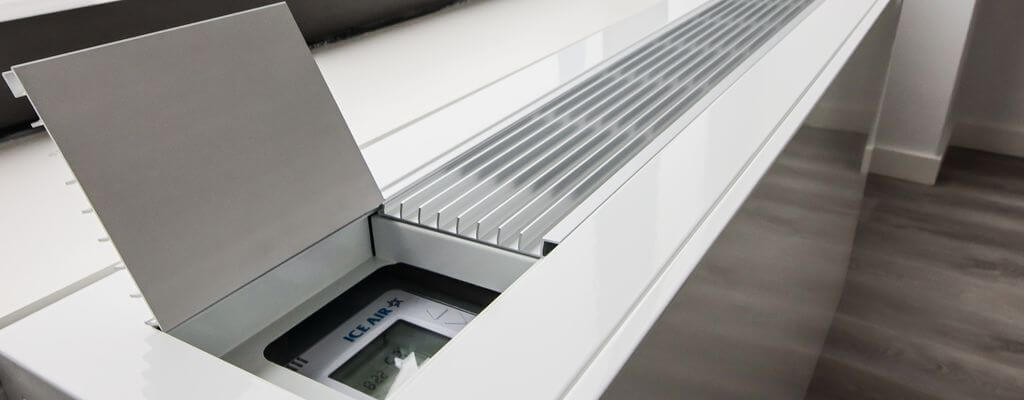 Innovative HVAC Solutions: Efficiency Meets Comfort
Innovative HVAC Solutions: Efficiency Meets Comfort
Ice Air’s RSXC cold climate heat pump was the only heat pump available on the market at that time that could operate at low ambient temperatures without the need for supplemental electric heat.
“Instead of needing to go through a costly design change, Ice Air’s RSXCs were an easy replacement for the PTACs that the building had been designed for,” Tom Glass, Ice Air’s Sales and Marketing Director. “Electric heat would have required a much greater power load. Furthermore, the gas risers in the design could be repurposed as condensate risers, allowing for a smooth electrification of the HVAC for the project. It was a way to achieve their design objectives.”
Hannigan notes, “The design was already set up for PTACs, so changing to a VRF system would have been a pain and cost prohibitive. Electric resistance heat would have demanded much more power. Switching to Ice Air allowed us to stay within the existing power load and adapt the gas risers to condensate risers – a win win.”
Precision Solutions for Affordable Housing
When it comes to affordable housing, the building was required to pay for heating but not for cooling. “The owner had specific ideas from the start, including direct metering for a 766-unit building,” Thomson points out. “Their requirements drove many of the design decisions we had to make, such as splitting power sources between heating and cooling to meet billing needs without tenant metering. Ice Air worked along side of us to make that happen.”
Ice Air arranged for a rib relay to split the power source so that heating goes to the owner and cooling goes straight to each individual unit.
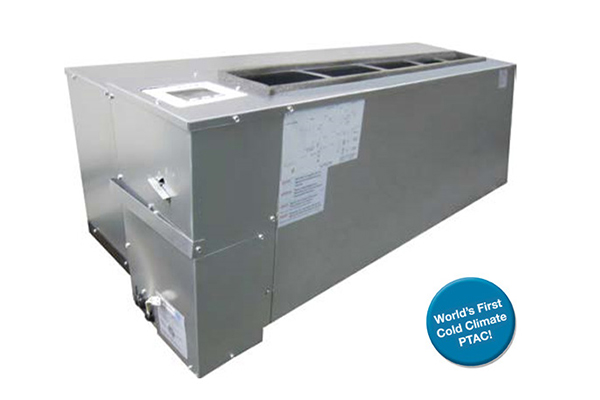 “The RSXC also provided 60 CFM of outside air, more than satisfying the demands for ventilation directly through the unit without the need for an ERV (Energy Recovery Ventilation) system,” Glass explains.
“The RSXC also provided 60 CFM of outside air, more than satisfying the demands for ventilation directly through the unit without the need for an ERV (Energy Recovery Ventilation) system,” Glass explains.
“Some of the units had electrical heat added to meet the heat load requirements with the heat switching on automatically when ambient temperature reached single digits” Hannigan adds. “The units were installed with 7-day programmable thermostats, allowing each resident full control of their heating and cooling.”
77 Commercial was one of the first projects where Ice Air employed their innovative fully cold climate PTHPs. The company was one of the first to develop this technology, the engineers verified their performance integrity. “We went to the Ice Air location in Mount Vernon and saw the unit operating at -4 degrees” says Hannigan. “After all, seeing IS believing,”
A Model Case for Cost-Efficient, Sustainable Development
77 Commercial is a model of modern urban development, blending architectural sophistication with cutting-edge HVAC engineering. From its compliance with LL97 to its innovative HVAC solutions to facilitating the integration of mechanical rooms, risers, refrigerant piping within the space constraints, the building addresses the complex demands of New York City’s residential market setting a benchmark for sustainability and design.
Through the collaboration of architect, engineer, and manufacturer, 77 Commercial demonstrates how thoughtful design and cost-efficient systems can create a building that is not only functional but also forward-thinking. It is more than a residential complex—it is a reflection of Brooklyn’s evolving skyline and a step toward a more sustainable future.

